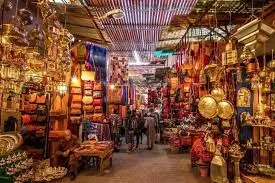Ochre, also known as Marrakech, is a fascinating place in North African Morocco. The city for its unique colors, vibrant culture, and rich history.
Eddie Hart finds out why the captivating North African city of Marrakech, with its fusion of French, Islamic, and Berber traditions, has inspired painters, designers, and musicians for generations.
As soon as I exit the airport, the heat of North Africa hits me like a wall. A man with a gray beard and a knitted kufi, an Islamic prayer headgear, leads me to a faded yellow taxi that looks like an old Mercedes-Benz. The driver, heavy with an unusual accent, asks me in French where I’m going.
“If you please, I’d like to go to Riad Jardin Secret,” I reply as I sink into the chair. The smell of diesel fills the room as the crackling radio blares Arabic music. As I lean out the window, motorcyclists fly past in their billowing djellabas, and the hot air pushes my hair back.
The history of Ochre City dates back over a millennium when it was a caravan town along the sub-Saharan trade routes that twisted north from Timbuktu. The city established in 1062 by the Almoravid dynasty, during a time when the area functioned as a Berber entry point to the Sahara Desert.
The foundation of modern Marrakech, one of the major cities of the Maghreb, built using salmon-pink rammed earth, which was also used to construct a mosque, a fortified citadel, ramparts, and monumental gates.
I head out of the souks and toward the 19th-century Bahia Palace, a kaleidoscope of cobalt, saffron yellow, and peacock blue that once housed a harem at the height of its extravagance.
I head to El Badi Palace, where storks have built enormous nests in the remains of the rammed-earth walls, for a peek into the realm of Saadian sultans, who ruled the country in the sixteenth and seventeenth centuries. Not far away is the Saadian Tombs, a magnificent marble tomb. Paul Bowles, an American writer who lived in Morocco for more than 50 years, remarked,
“There are certain places on the surface of the earth that possess more magic than others. Marrakech is one of those places.”
I settle into a booth at Café Clock, a relaxed cultural hotspot in the Kasbah neighborhood that is a little off the main path.
It’s furnished with an eclectic mix of pieces and features vivid artwork on the walls. They have a regular hikayat (traditional storytelling) session that I missed, but I made up for it by trying their renowned camel burger and delicious date milkshake.
I take a taxi uptown to Jardin Majorelle’s shaded canopy in order to get away from the scorching heat. Above the vivid blue front and Art Deco mansion lie lush grounds teeming with vivid bougainvillea and towering cacti.
This surreal scene painted by French painter Jacques Majorelle for forty years before being purchased by Yves Saint Laurent. The greater city and the botanical oasis served as inspiration for the fashion designer. Frequently cited, he remarked, “Marrakech was a great shock to me.” I learned about color in this city.
The building is one of hundreds of riads, which are centuries-old Moroccan homes that usually have a sun-filled rooftop patio and an internal courtyard. Nestled behind the earthen walls of the medina and hidden behind elaborate doors, these magnificent guesthouses exude a romantic aura by nature.
Feeling rejuvenated after the liquid sugar, I return to Marrakech’s bustle. The souks have been a part of the city’s rich legacy for centuries, hardly changing. The market’s thatched canopy illuminated by golden light, and a treasure trove of storefronts fills the maze-like passageways.
The major thoroughfare is Souk Semmarine, a market crammed with antiques, fabrics, ceramics, rugs, and pastry shops brimming with Arabic sweets so sweet they attract bumblebees.
Even though I’m only here for a few days, I want to experience the charm that has long captivated foreign authors and artists. Marrakech’s Ville Nouvelle (New Town) is set against a backdrop of broad boulevards dotted with tangerine trees, cafés, and Art Deco buildings. We drive past the Gueliz neighborhood, which dates back to the French protectorate in the middle of the 20th century, and toward the city’s well-known medieval-plan medina.
Orderly avenues give way to bustling, dilapidated streets, and before long, the taxi can travel no farther. It’s up to me to walk through the labyrinthine lanes. Before I can even get my bearings, a bunch of little boys have my bags loaded onto a rickety wheelbarrow. They reassure me, “It’s okay, we’ll take you to Riad Jardin Secret,” upon noticing my alarm. I follow, twisting and turning through the confusing maze of alleys.
1. Why is it called Ochre City?
It was nicknamed the “Ocher City” because of the unique yellow-brown color of the buildings and walls. The use of natural red clay in the architecture gives Marrakech its signature color, creating a warm and inviting atmosphere throughout the city.
2. A Little History
Marrakesh was founded in 1070 by the Almoravids. It has been an important cultural, religious, and commercial center for centuries. A blend of influences from Arab, Berber, and French cultures makes the city a vibrant melting pot of traditions and styles.
3. The main attraction Of Ochre City
Jema El-Fna: This vibrant street is the center of Marrakech. During the day, it bustles with restaurants, snake charmers, and street performers. At night, it transforms into an open-air restaurant with delicious local food.
4. Medina
The Old Town consists of quaint narrow streets filled with shops selling spices, textiles, and handicrafts. Medina is also a UNESCO World Heritage Site.
5. Koutoubia Mosque
The largest mosque in Marrakesh is also known for its impressive 12th-century chapel. Non-Muslims are allowed inside, but the street and surrounding gardens are beautiful to explore.
6. Majorelle Gardens
A peaceful retreat with exotic plants, fountains, and bright blue buildings. Its also designed by French designer Jacques Majorelle and later restored by fashion icon Yves Saint Laurent.
Bahia Palace – An impressive 19th-century palace with stunning architecture, beautiful courtyards, and lush gardens.
7. Culture and food
Marrakech is a center for Moroccan cuisine. You can try traditional dishes like tagine, couscous and pastilla. The city also known for its classic sweet mint tea as a symbol of hospitality.
Cultural festivals and markets (souks) abound in Marrakech. The souks are filled with colorful clothes, cutlery, lamps, and carpets. They look forward to making purchases, which makes shopping fun.
Walking is the best way to explore the narrow streets of the medina. Long distances can be Traveled by taxi or horse-drawn carriage called a calèche.
1. Koutoubia Mosque In Marrakech
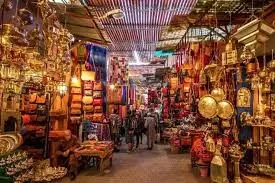
Koutoubia Mosque in Marrakesh is the largest mosque in the city. Built in the 12th century, it is famous for its beautiful residence that stands 77 meters high. The architecture of the church is impressive, with intricate details and stunning arches. However, Non-Muslims not allowed to enter the mosque, and visitors can see its exterior and explore the surrounding gardens. The Koutoubia Mosque is a must-visit and an iconic landmark of Marrakech.
2. Koutoubia Mosque In Ochre City
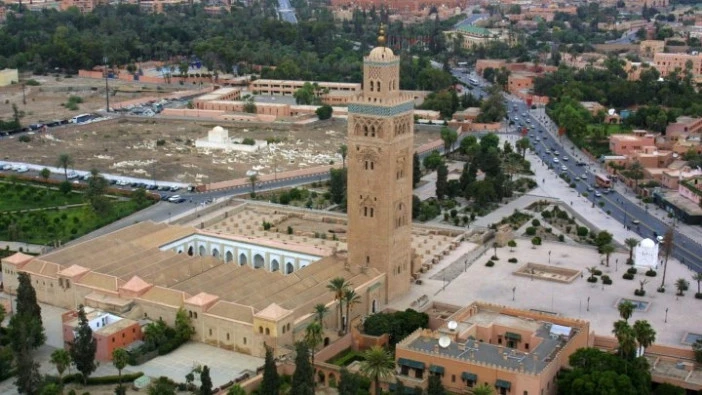
The Koutoubia Mosque in Marrakech is the largest and most famous mosque in the city. Built in the 12th century, it has a soaring 77-metre minaret that can be seen for miles. The architecture of the church is beautiful, with elaborate carvings and archways. Although non-Muslims are not allowed inside, the square and its gardens are wonderful to explore. The Koutoubia Mosque is an impressive landmark and a symbol of Marrakech’s rich history and culture.
3. Unky Cold Medina
The Marrakesh Medina is the old, historic part of the city, often called the “Anky Cold Medina” for its shady, cool streets. The area is made up of quaint narrow streets filled with bustling markets, or souks, offering everything from spices, textiles, and handicrafts making the Medina a UNESCO World Heritage Site, reflecting its rich history and culture in the sense of revealed. Exploring its vibrant streets gives you a real taste of traditional Moroccan life.
4. Jemaa el-Fnaa
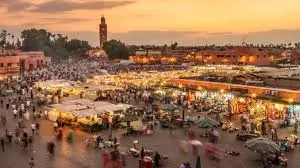
Jema el-Fna is Marrakesh’s busiest main street, known for its vibrant atmosphere. During the day, its filled with restaurants, street performers, snake charmers, and vendors selling a variety of goods. As night falls, the park transforms into an open-air restaurant with delicious local food and live entertainment. This hotspot is a must-visit, offering a glimpse into Marrakesh’s culture and daily life.
5. Majorelle Garden
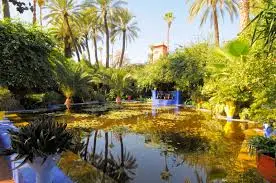
Majorelle Park is a beautiful and serene park in Marrakech, designed by French artist Jacques Majorelle in the 1920s and 1930s. Known for its cobalt-blue buildings, this filled with exotic plants, fountains, and shady paths. However, it was later restored by fashion designer Yves Saint Laurent, who was inspired with quiet beauty. Visitors can explore the lush vegetation, relax by the pool, and visit the Berber museum inside the park. Majorelle Park is a must-visit for nature lovers and those looking for a peaceful getaway in the city.
6. Bahia Palace
The Bahia Palace in Marrakesh is an impressive 19th-century palace that showcases Moroccan architecture at its best. Built by Si Moussa, the Sultan’s grand vizier, the palace features impressive tile work, beautiful stucco, and lush gardens. Its name “Bahia” means “shining” and reflects its majesty and beauty. Visitors explore the palace’s many rooms, courtyards, and gardens, each one richly decorated. The Bahia Palace offers a glimpse into the lavish lifestyle of Moroccan royalty and is a must-see in Marrakech.
7. Saadian Tombs

The Bahia Palace in Marrakesh is an impressive 19th-century palace that showcases Moroccan architecture at its best. Built by Si Moussa, the Sultan’s grand vizier, the palace features impressive tile work, beautiful stucco, and lush gardens. Its name “Bahia” means “shining” and reflects its majesty and beauty. You can explore the palace’s many rooms, courtyards, and gardens, each beautifully decorated. The Bahia Palace offers a glimpse into the lavish lifestyle of Moroccan royalty and is a must-see in Marrakech.
8. El Badi Palace In Orchre City
El Badi Palace in Marrakesh was once a magnificent palace built by Sultan Ahmed Al Mansur in the late 16th century. Although, now in ruins, As the “palace of peerlessness” because of its immense size and elaborate design. However, The beautifully decorated place with gold, precious stones, and precious stones. Meanwhile, Today, visitors can explore the remains of the palace with its vast courtyards, sunken gardens, and spectacular reflecting pools. El Badi Palace offers a glimpse into the rich past life of Morocco and is a beautiful historic site.
9. Menara Gardens

Located on the edge of Marrakech, Menara Park a tranquil retreat known for its stunning olive trees and large reflective pool. Founded in the 12th century by the Almohad ruler Abd al-Mu’min, the gardens designed as places for relaxation and agricultural use Central pavilions built in the 19th century have a beautiful backdrop of the Atlas Mountains. Visitors to Menara Park can stroll among the olive trees, relax by the pool, and take in the serene beauty of this serene historic site.
10. Marrakech Museum
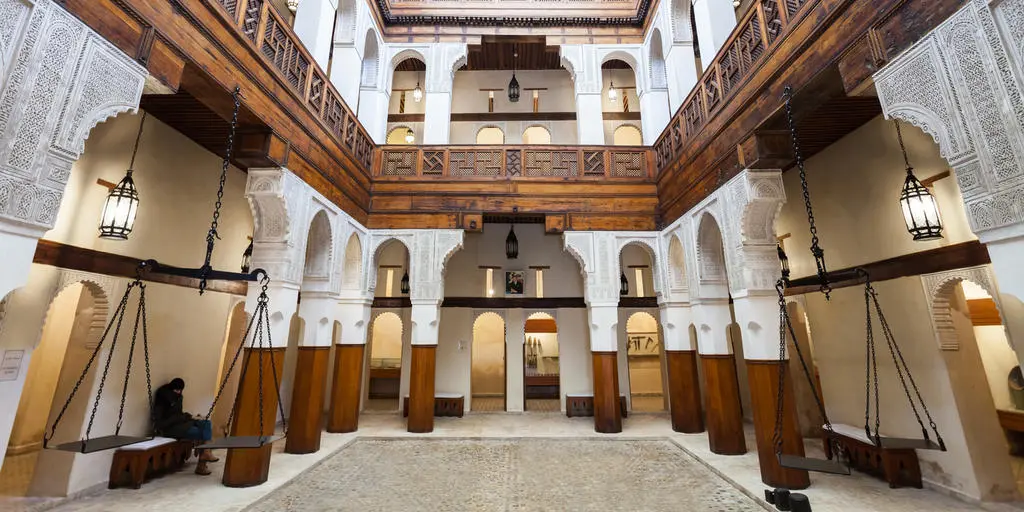
The Marrakech Museum is a cultural treasure trove in the heart of the city’s medina. However, Located in the beautiful 19th-century Dar Menebhi Palace, the museum showcases Moroccan masterpieces including traditional ceramics, textiles, and jewelry. Meanwhile, The building itself is a masterpiece of Moroccan architecture, with a courtyard that is stunning with incredible tile work and stunning chandeliers. Whatever, Visitors can explore a variety of exhibits highlighting the area’s historical, cultural, and artistic heritage. The Marrakech Museum offers an insightful and visually exciting experience, making it an indispensable attraction of Marrakech.
11. Almoravid Koubba
The Almoravid Kaubba, also known as the Kaubba Ba’adin, is a major historical landmark in Marrakech. However, Built during the Almoravid dynasty in the 12th century, it is one of the oldest surviving structures in the city. Therefore, The kubba originally used for massaging before prayer, with intricate design and large arches that reflect the architectural style of the time Despite its small size, Whatever, the Almoravid Kaubba is a Moroccan prime example of heritage, offering insights into the city’s past and art dating back to the Almoravid era.
12. FAQs
Q1. Why is Marrakesh/Orchre City so famous?
Marrakech noted for its parks, especially the Menara olive groves and walled 405-hectare Agdal gardens, and more recent additions such as the Jardin Majorelle (created by the French painter and acquired in the sixties by Yves Saint Laurent) and the wonderfully recreated medieval Secret Garden in the heart of the …
Q2. Why is Orchre City called the Red City?
Surrounded by palm groves, the Medina in Marrakech is called the Red City because of its buildings and ramparts of beaten clay, which were built during the residence of the Almohads. The heart of the medina is Jamaa el-Fna Square, a vibrant marketplace.
Q3. What is Morocco/Orchre City famous for?
What is Morocco known for?
- Rich History and Magnificent Monuments:
- Food Diversity:
- Medinas of Morocco:
- Camel Ride, Sand Dunes, and Quad Biking:
- The Staggering Atlas Mountains:
- Variety of Beaches:
- Ski Resorts of Morocco:
- Unique Culture of Morocco:
Q4. What are 5 interesting facts about Morocco Or Ochre City?
10 Things you didn’t know about Morocco
- Morocco is the most visited country in Africa. …
- Most Moroccans are multilingual. …
- Moroccans love coffee, but worship tea. …
- Morocco has the oldest university in the world. …
- Morocco has the second-oldest ruling dynasty in the world. …
- Morocco has been a beloved refuge for artists.
Q5. Is Morocco cheap to travel to?
Overall, the cost of traveling to Morocco can range from a few hundred to several thousand dollars per person, depending on your travel style and preferences. Whether you’re a family, couple, or single traveler, expect to spend anywhere from $500 to $5000 for a trip to this captivating country.
13. Conclusion
Ochre City offers a unique blend of history, culture, and color in Marrakech. Whether you’re wandering its ancient streets, sampling local specialties, or marveling at its architecture, Marrakesh will captivate your imagination and is sure to leave you with unforgettable memories

